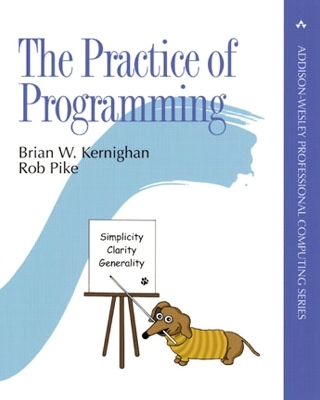Addison-Wesley Professional Computing
2 total works
With the same insight and authority that made their book The Unix Programming Environment a classic, Brian Kernighan and Rob Pike have written The Practice of Programming to help make individual programmers more effective and productive.
The practice of programming is more than just writing code. Programmers must also assess tradeoffs, choose among design alternatives, debug and test, improve performance, and maintain software written by themselves and others. At the same time, they must be concerned with issues like compatibility, robustness, and reliability, while meeting specifications.
The Practice of Programming covers all these topics, and more. This book is full of practical advice and real-world examples in C, C++, Java, and a variety of special-purpose languages. It includes chapters on:
- debugging: finding bugs quickly and methodically
- testing: guaranteeing that software works correctly and reliably
- performance: making programs faster and more compact
- portability: ensuring that programs run everywhere without change
- design: balancing goals and constraints to decide which algorithms and data structures are best
- interfaces: using abstraction and information hiding to control the interactions between components
- style: writing code that works well and is a pleasure to read
- notation: choosing languages and tools that let the machine do more of the work
Kernighan and Pike have distilled years of experience writing programs, teaching, and working with other programmers to create this book. Anyone who writes software will profit from the principles and guidance in The Practice of Programming.
The authoritative resource to writing clear and idiomatic Go to solve real-world problems
Google’s Go team member Alan A. A. Donovan and Brian Kernighan, co-author of The C Programming Language, provide hundreds of interesting and practical examples of well-written Go code to help programmers learn this flexible, and fast, language. It is designed to get you started programming with Go right away and then to progress on to more advanced topics.
- Basic components : an opening tutorial provides information and examples to get you off the ground and doing useful things as quickly as possible. This includes:
- command-line arguments
- gifs
- URLs
- web servers
- Program structure : simple examples cover the basic structural elements of a Go program without getting sidetracked by complicated algorithms or data structures.
- Data types: Go offers a variety of ways to organize data, with a spectrum of data types that at one end match the features of the hardware and at the other end provide what programmers need to conveniently represent complicated data structures.
- Composite types :
- arrays
- slices
- maps
- structs
- JSON
- test and HTML templates
- Functions : break a big job into smaller pieces that might well be written by different people separated by both time and space.
- Methods :
- declarations
- with a pointer receiver
- struct embedding
- values and expressions
- Interfaces : write functions that are more flexible and adaptable because they are not tied to the details of one particular implementation.
- Concurrent programming : Goroutines, channels, and with shared variables.
- Packages : use existing packages and create new ones.
- Automated testing : write small programs that check the code.
- Reflection features : update variables and inspect their values at run time.
- Low-level programming : step outside the usual rules to achieve the highest possible performance, interoperate with libraries written in other languages, or implement a function that cannot be expressed in pure Go.
Each chapter has exercises to test your understanding and explore extensions and alternatives. Source code is freely available for download and may be conveniently fetched, built, and installed using the go get command.

